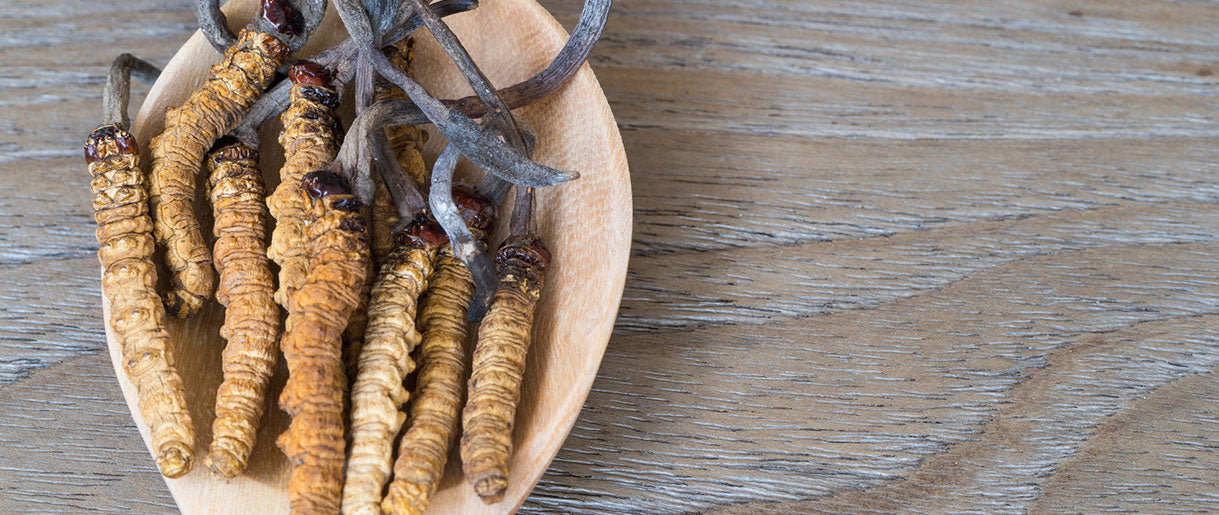From treating depression to helping manage fungal infections, researchers say medicinal mushrooms have many potential benefits. Make no mistakes; these are not magic shrooms but functional mushrooms. And Cordyceps is no different.
Cordyceps mushrooms have long been regarded as miracle medicinal plants. For ages and worldwide, they have been utilized as cures for various diseases. Despite this, we are still far from learning everything there is to know about the antifungal potential of Cordyceps mushrooms.
Let’s explore Cordyceps Candida benefits and how to integrate the mushroom into your daily wellness lifestyle.
Understanding Candida Overgrowth

Candida is a type of yeast fungus. It is found naturally on the skin and in the human body, particularly in the intestines, ears, mouth, bladder, vagina, stomach, and lungs. It is one of the billions of other beneficial organisms in the body.
Candida albicans is crucial in recognizing and destroying dangerous microorganisms and poisons. However, Candida is not meant to grow and become out of control while the body is still alive. That transformation is only supposed to occur when the body dies when Candida's functions and properties alter to break down the body.
Candida may grow out of control and create an infection. Candidiasis is the medical word for the infection. A healthy immune system maintains the equilibrium of Candida and other microorganisms in the mucosal membranes. However, under some conditions, Candida tends to overgrow and become unmanageable.
Candida can be caused by anything that suppresses the immune system, but antibiotics are the most common offenders since they wipe away beneficial microorganisms, particularly in the digestive tract. Candida is resistant to antibiotics. Thus this microorganism imbalance helps it to take over. Other factors that suppress the immune system include, to name a few, inadequate nutrition, environmental pollutants, medicines, immunizations, and stress.
Introducing Cordyceps

Cordyceps mushroom, commonly known as Chinese caterpillar fungus or "Dong Chong Xia Cao" in Chinese, is a peculiar blade-shaped fungus that grows on caterpillars and is a highly prized tonic herb that is said to treat a variety of ailments. This rare and valuable edible and medicinal herb has long been utilized in Traditional Chinese Medicine (TCM) therapy for renal, pulmonary, liver, and cardiovascular disorders, impotence and poor libido, and hyperlipidemia.
C. sinensis feeds on ghost moth larvae in Bhutan and Nepal's Himalayan regions. Due to increased demand, the wild fungus has been over-collected, making naturally produced C. sinensis practically impossible to locate. In recent years, Companies have mass-produced farmed C. sinensis, which is C. militaris, to meet demand.
Polysaccharide, one of Cordyceps' bioactive constituents, has a broad spectrum of bioactivities. Cordyceps polysaccharide research has received increased attention due to its multi-pharmacological properties such as anti-tumor, antifungal, immunomodulation, antioxidant, renal and liver protective effects, hypoglycemia, etc.
Several studies(1) indicate that Cordyceps has a bioactive component known as cordycepin. Cordycepin's antifungal activity against Candida infections was examined and found positive. According to laboratory investigations, cordycepin and Cordyceps polysaccharides may have additional anti-inflammatory properties.
Now let’s exploreCandida Cordyceps for Candida.
Cordyceps And Candida

According to research, Cordyceps mushroom aids in treating candida infections in the body. A 2021 study(2), for example, assessed cordycepin's anti-biofilm efficacy against Candida albicans. Candida albicans can form biofilms, leading to drug resistance and a high risk of medical therapy.
Researchers looked into C. albicans' ability to develop biofilms on various materials and the eradicating and inhibitory effects of cordycepin on biofilm. Cordycepin strongly suppressed and eliminated biofilms by decreasing metabolic activity, the ratio of live cells, and destroying biofilm extracellular polysaccharides, according to the findings of this study. These findings should allow for more effective use of cordycepin and point to a new avenue in treating fungal diseases.
Although fighting a fungal illness with a fungus may appear counter-intuitive, the evidence speaks for itself. A cordyceps pill can help you get rid of Candida. However, cordycepin is also found in powders and tinctures, which are generally regarded as the most potent supplementation.
Cordyceps As An Antifungal Aid

Cordyceps tea is a wonderful way to obtain these immunomodulatory and antifungal compounds. It can be taken daily as morning and evening tea, with or without meals. The Cordyceps fruit bodies can also be used in soups and eaten raw. Cordyceps tea can also be stored in a glass jar for subsequent use without compromising the vital ingredients' efficacy. Taking Cordyceps as tea offers increased bioavailability and faster absorption of biomolecules in the body.
The fungus can also be dried and packaged in "00" capsules, with an average of 400 mg of powdered mushroom. It is therefore recommended to take up to two capsules in the morning and evening for antifungal support.
Integrating Cordyceps Into Your Candida Management

It is possible to stop candida overgrowth and restore balance to your body by changing your diet and lifestyle and using Cordyceps supplements. Here are some candidiasis management tips.
- Reduce your carbohydrate intake.
- Reduce your sugar intake.
- Choose gluten-free items.
- Avoid dairy products with high lactose content.
- Reduce your alcohol consumption.
However, consult with a healthcare expert before utilizing Cordyceps as part of a candida management plan.
FAQs About Cordyceps candida
How Long Does It Typically Take To See Results When Using Cordyceps For Candida Relief?
According to research, the antifungal effects of Cordyceps might be noticed in as little as two weeks. Regular use of a daily dose provides even greater benefits.
Is Cordyceps Safe To Use For Candida Overgrowth, And Are There Any Potential Side Effects To Be Aware Of?
Cordyceps is likely safe for most people when taken orally in 3-6 grams daily for up to a year. Mild adverse effects such as constipation, diarrhea, and stomach upset are possible.
Can Cordyceps Be Used As A Standalone Treatment For Candida?
Cordyceps mushrooms are not intended for use as a standalone treatment for Candida. Instead, they should be combined with antifungal medications recommended by your healthcare provider.
Key Takeaways
Research has shownCordyceps candida benefits, and we have broken it down for you. The traditionally revered mushroom contains cordycepin and polysaccharides, which help fight yeast infection. So, make yourself a cup of Cordyceps tea the next time you tackle the infection.
References
- Anti-inflammatory effects of cordycepin: A review, (1)https://pubmed.ncbi.nlm.nih.gov/33090621/
- Evaluation of Anti-Biofilm Capability of Cordycepin Against Candida albicans, (2)https://www.ncbi.nlm.nih.gov/pmc/articles/PMC7872900/









Let Us Know Your Comments